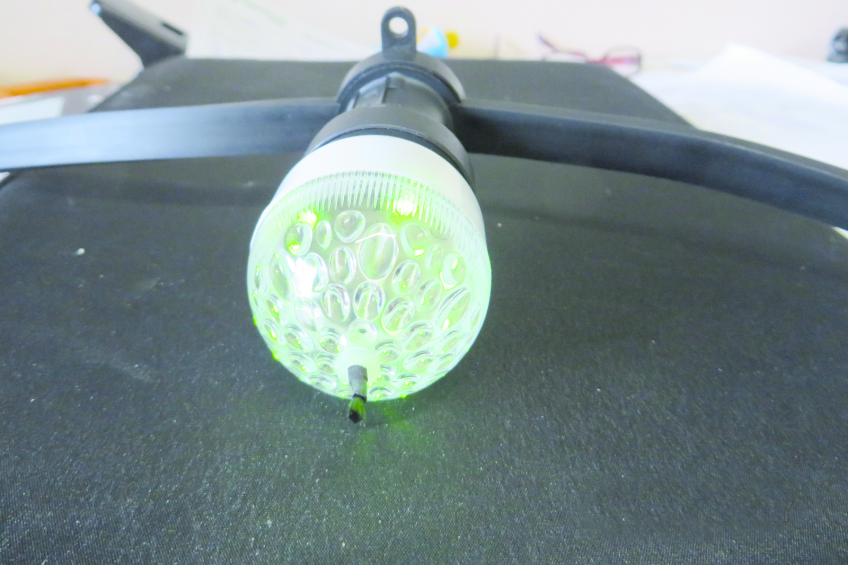A better climate for broilers from day one

In his search to replace existing lighting in his broiler houses Bernard Wolters selected ionisation lamps by chance. Now he is delighted with this choice.
The decision of broiler farmer Bernard Wolters’ (54) to use ionisation lamps was an unintended consequence of the transition of regular illumination lamps to the use of LED lamps in his houses. This liberated two out of four rows of lighting fixtures. Wolters: “The vendor of the company Freshlight-Agri, which installed the LED lamps suggested to place ionisation lamps in the released fittings. We treated it like a laughing matter at first, as at that time we had no idea what the function of those lamps could be.”
Normal fitting, so easily placeable
Initially, at the beginning of 2014 in one house 42 ionisation lamps were placed in the present luminaires (about 55 m2 surface per lamp) with a production of 5 million units/m3/second each. The lamps have normal E27 fittings, making them easy to be installed. Next, weekly measuring’s were conducted in order to see the lamps’ actual effects.
Wolters: “The first results were incredible. The house’s climate was significantly better from day one. We measured a distinct difference in dust production compared to the other houses. We installed even more powerful lamps with a capacity of 25 million units per lamp. It is worth noting the lamps, as odd as it sounds, give no light. The lamps are continuously operational for 24 hours per day with approximately 0.6 Watt power consumption per lamp.”
Beneficial for environment and the poultry house
The fact that the poultry farmer was aware of the certain impact poultry houses have on the environment was an important reason for him to choose ionisation lamps. Wolters: “I want to contribute to the reduction of the impact, yet preferably by means of a system which is beneficial to the chickens as well. Not an air scrubber which is beneficial to the outside world, but a system that brings something positive to the house.”
Ions wash unwanted particles from the house air
In the ionisation process negative ions are brought into the house
by ionisation lamps. These negative ions are air molecules with a negative charge. These negatively charged particles connect to dust fractions in the air and then bond to a ground surface.
Dust and other chemical particles (such as ammonia) in the air are predominantly positively charged and will be as such washed from the air by the negative ions. Scientific research has shown that enriching air with negative ions eliminates particulate matter, ammonia, viruses and bacteria.
The ionisation lamps immediately provided the broiler farmer with a good impression of the climate. Measurements confirmed the initial impression. “At first we thought the house’s ventilation levels to be higher with ionisation lamps, in comparison with the other houses, as the climate felt better. However, after we checked, ventilation turned out to be equivalent to the other houses. The effect was clearly caused by the lamps.”
Also the dust production was considerably lower than in other houses, when ionisation lamps were used. The dust is deposited on the litter much faster. “Even after three weeks time everything was rather free of dust, in particular compared to the other houses.”
After measuring, the results were clear: 30% less ammonia and 30% less dust in the air. The effect of ionisation is particularly notable in a situation with a minimal ventilation of 30-40%. Wolters: “We must not overlook the fact that this ventilation range is used during at least 80% of the season. This amplifies the advantage of this impact.”
In the ionisation process negative ions are brought into the house by ionisation lamps. These negative ions are air molecules with a negative charge.
Earn back in three rounds
The broiler farmer is visibly satisfied with the performance of the ionisation lamps and can list varying positive points. “The chickens are raised in a healthier climate with less ammonia and less dust. This definitely delivers benefits. During the first three rounds we established a continuous 1.5-2% decrease in mortality, spread over an entire round. As a consequence the total mortality per round is only 1.3-1.5%. We also have a clear impression that the flocks have better uniformity. And this reflects in a 1 to 3 points lower feed conversion. Less medication and a delivery weight which is at least 30-40 grams higher than in other houses count as other advantages.” Moreover, it does not only benefit the chickens, but also the caregivers who consider the air more pleasant.
The broiler farmer is satisfied with the performance of the ionisation lamps which established a continuous 1.5-2% decrease in mortality during the first three rounds.
Currently these ionisation lamps are already installed in five out of eight houses. At the earliest opportunity the lamps will be installed in the other houses as well.
Also during the cleaning period the light bulbs are not turned off. The poultry farmer: “We think the lamps should continuously do their job, allowing the animals to enter a clean environment. The investment in the acquisition amounts to approximately €1 per square meter house surface. With the mentioned advantages you may expect the investment to be recouped within three rounds.”
To the government
Poultry farmers like Wolters are open to new systems that contribute to an improvement for the animals and their environment. Father Bernard Wolters points out another general advantage: “When there will be more clear results on usage of these ionisation lamps, we can take these to the government in order to clarify to them that newly implemented systems in the house, to improve the quality of the ventilating air for instance, benefits both the outside world and the animals inside the house.”
This article was featured in World Poultry magazine no. 1, 2015. To read more printed articles see our digital magazine













